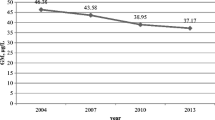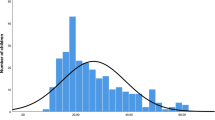Abstract
Lead poisoning is one of the most significant environmental health threats which children face. The aim of the study was to evaluate the relationship between the blood lead level (BLL) of children and environmental pollution, as well as the effect of BLL on children’s heath, in the biggest city in south-west China. A questionnaire survey was administered to 3,624 children’s (6 months–7 years old) guardian in urban Chengdu from 2007 to 2009, collecting data on inhabited environment, living habits, and health status. All blood samples were collected for BLL test when the children came to the hospital. The analysis was conducted in West China Second University Hospital, Chengdu, China in December, 2009. A total of 3,624 children were included. The mean BLL was 62.31 μg/L. Three hundred thirty-three (9.2%) of 3,624 children’s BLL were above 100 μg/L. Taking Chinese medicinal herbs usually, puffed foods, and substitutes of breast milk were risk factors (P < 0.05).The study shows that Chinese children’s lead poisoning prevention and treatment lags far behind developed countries. The findings have implications for environmental health policy.
Similar content being viewed by others
References
Alliance to End Childhood Lead Poisoning and the Environmental Defense Fund (1994) The global dimensions of lead poisoning: an initial analysis. Alliance and EDF, Washington, D.C.
Canfeld RL, Henderson CR Jr, Cory-Slechta DA et al (2003) Intellectual impairment in children with blood lead concentrations below 10 μg per deciliter. N Engl J Med 348:1517–1526
Mendelsohn AL, Dreyer BP, Fierman AH et al (1999) Low-level lead exposure and cognitive development in early childhood. J Dev Behav Pediatr 20:425–431
Romieu I, Lacasana M, McConnell R et al (1997) Lead exposure in Latin America and the Caribbean. Environ Health Perspect 105:398–405
US Centers for Disease Control (1991) Preventing lead poisoning in young children. Atlanta
International Programme on Chemical Safety (IPCS) (1995) Inorganic lead, Environmental Health Criteria 165. WHO, Geneva
Schmidt CW (2002) e-Junk explosion. Environ Health Perspect 110(4):A188–94
Zhang SM, Dai YH, Xie XH et al (2009) Surveillance of childhood blood lead levels in 14 cities of China in 2004–2006. Biomed Environ Sci 22(4):288–296
Bloch AB, Rosenblum LR, Guthrie AM (2000) Recommendations for blood lead screening of young children enrolled in medicaid: targeting a group at high risk (Advisory Committee on Childhood Lead Poisoning Prevention, ACCLPP). MMWR Recomm Rep 49:1–13
Flegal AR, Smith DR (1992) Lead levels in preindustrial humans. N Engl J Med 326:1293–1294
Author information
Authors and Affiliations
Corresponding author
Rights and permissions
About this article
Cite this article
Shi, H., Jiang, Ym., Li, Jy. et al. Environmental Lead Exposure Among Children in Chengdu, China, 2007–2009. Biol Trace Elem Res 143, 97–102 (2011). https://doi.org/10.1007/s12011-010-8849-0
Received:
Accepted:
Published:
Issue Date:
DOI: https://doi.org/10.1007/s12011-010-8849-0




